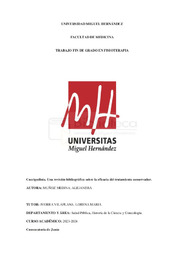Por favor, use este identificador para citar o enlazar este ítem:
https://hdl.handle.net/11000/33660Registro completo de metadatos
| Campo DC | Valor | Lengua/Idioma |
|---|---|---|
| dc.contributor.advisor | Ivorra Vilaplana, Lorena María | - |
| dc.contributor.author | Muñoz Medina, Alejandra | - |
| dc.contributor.other | Departamentos de la UMH::Salud Pública, Historia de la Ciencia y Ginecología | es_ES |
| dc.date.accessioned | 2024-10-25T11:09:14Z | - |
| dc.date.available | 2024-10-25T11:09:14Z | - |
| dc.date.created | 2024-05-30 | - |
| dc.identifier.uri | https://hdl.handle.net/11000/33660 | - |
| dc.description.abstract | Introducción: La coccigodinia se define como dolor en el cóccix cuyas causas pueden ser muy diversas, siendo la más habitual el traumatismo directo o indirecto donde pueden lesionarse las partes blandas o esqueléticas relacionadas con el cóccix. Es un trastorno poco frecuente e incomprendido que afecta mayormente a la calidad de vida y funcionalidad de quien la padece. Desde la fisioterapia se proponen varias técnicas como abordaje de primera línea para el manejo de la coccigodinia. Objetivos: Determinar la eficacia de las técnicas fisioterápicas para tratar las diferentes estructuras alteradas causantes de la coccigodinia, así como identificar su impacto en la calidad de vida y discapacidad e indicar el tiempo de intervención y sesiones necesarias en cada técnica para obtener resultados significativos. Metodología: Se realizó una revisión bibliográfica en seis bases de datos distintas. Del total de artículos encontrados, tras analizar los criterios de elegibilidad, se incluyó un total de 11 artículos, de los cuales, 8 fueron ensayos clínicos y 3 estudios observacionales, cuya calidad metodológica se evaluó con la escala PEDro. Resultados: Las técnicas manuales de estiramientos y masaje de la musculatura hipertónica, así como su relajación específica con la técnica de relajación del reflejo primario (PRRT), ejercicios activos para la musculatura débil o discinética, movilización y manipulación del cóccix y las ondas de choque extracorpóreas (ESWT) resultan efectivos en el tratamiento de la coccigodinia crónica a corto y medio plazo. Conclusiones: Las técnicas fisioterápicas han resultado ser efectivas en el tratamiento del dolor y como consecuencia, en el aumento de la funcionalidad y calidad de vida pero no consiguen el alivio completo de los síntomas. | es_ES |
| dc.description.abstract | Introduction: Coccygodynia is defined as pain in the coccyx whose causes can be very diverse, the most common being direct or indirect trauma where the soft or skeletal parts related to the coccyx can be injured. It is a rare and misunderstood disorder that mainly affects the quality of life and functionality of those who suffer from it. From physiotherapy, several techniques are proposed as a first-line approach for the management of coccygodynia. Objectives: Determine the effectiveness of physiotherapy techniques to treat the different altered structures causing coccydynia, as well as identify their impact on quality of life and disability and indicate the intervention time and sessions necessary in each technique to obtain significant results. Methodology: A bibliographic review was carried out in six different databases. Of the total number of articles found, after analyzing the eligibility criteria, a total of 11 articles were included, of which 8 were clinical trials and 3 were observational studies, whose methodological quality was evaluated with the PEDro scale. Results: Manual stretching and massage techniques for hypertonic muscles, as well as their specific relaxation with the primary reflex relaxation technique (PRRT), active exercises for weak or dyskinetic muscles, mobilization and manipulation of the coccyx and coccyx waves. Extracorporeal shock therapy (ESWT) is effective in the treatment of chronic coccygodynia in the short and medium term. Conclusions: Physiotherapeutic techniques have proven to be effective in the treatment of pain and, as a consequence, in increasing functionality and quality of life, but they do not achieve complete relief of symptoms. | es_ES |
| dc.format | application/pdf | es_ES |
| dc.format.extent | 37 | es_ES |
| dc.language.iso | spa | es_ES |
| dc.publisher | Universidad Miguel Hernández | es_ES |
| dc.rights | info:eu-repo/semantics/openAccess | es_ES |
| dc.rights | Attribution-NonCommercial-NoDerivatives 4.0 Internacional | * |
| dc.rights.uri | http://creativecommons.org/licenses/by-nc-nd/4.0/ | * |
| dc.subject | Coccidinia | es_ES |
| dc.subject | dolor de cóccix | es_ES |
| dc.subject | fisioterapia | es_ES |
| dc.subject | terapia manual | es_ES |
| dc.subject | tratamiento conservador | es_ES |
| dc.subject.other | CDU::6 - Ciencias aplicadas | es_ES |
| dc.title | Coccigodinia. Una revisión bibliográfica sobre la eficacia del tratamiento conservador. | es_ES |
| dc.type | info:eu-repo/semantics/bachelorThesis | es_ES |

Ver/Abrir:
TFG. MUÑOZ MEDINA ALEJANDRA.pdf
1,12 MB
Adobe PDF
Compartir:
 La licencia se describe como: Atribución-NonComercial-NoDerivada 4.0 Internacional.
La licencia se describe como: Atribución-NonComercial-NoDerivada 4.0 Internacional.
.png)